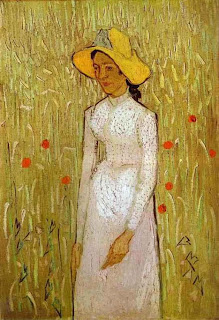 Whether driving around the Hollywood Hills in a Ferrari or walking the red-carpet dripping in diamonds, rich celebrities love flaunting their money in all of its materialistic forms. While celebrity blogs, magazines, and television shows detail these frequent and obnoxious happenings 24 / 7 (and I'll admit it, I'm somewhat entertained by this junk), there's something I've always wondered: how do celebs feel about art and what do their art collections look like?
Whether driving around the Hollywood Hills in a Ferrari or walking the red-carpet dripping in diamonds, rich celebrities love flaunting their money in all of its materialistic forms. While celebrity blogs, magazines, and television shows detail these frequent and obnoxious happenings 24 / 7 (and I'll admit it, I'm somewhat entertained by this junk), there's something I've always wondered: how do celebs feel about art and what do their art collections look like?Here's the dish:
 Former "Spice Girl" Victoria "Posh" Beckham and her hunky husband, famed soccer player David have a $45 million collection. Their "love themed" collection includes paintings, portraits and sculptures by Damien Hirst, Sam Taylor Wood, Tracey Emin, Banksy, and Jake and Dinos Chapman. One insider stated,
Former "Spice Girl" Victoria "Posh" Beckham and her hunky husband, famed soccer player David have a $45 million collection. Their "love themed" collection includes paintings, portraits and sculptures by Damien Hirst, Sam Taylor Wood, Tracey Emin, Banksy, and Jake and Dinos Chapman. One insider stated,"Victoria is a mover and shaker in more upmarket circles nowadays and likes being a 'collector'... She is even in talks with a museum to showcase some of their pieces - all of which are love tokens, presents David or Victoria gave to each other for birthdays, Christmas and special anniversaries." - How Sweet... the seemingly stoic and non-emotional "Posh" Spice has a heart full of love (and an eye for art).
 Additionally, in a recent interview with Rolling Stone Magazine, hip-hop superstar Jay-Z revealed that his super-star wife, Beyonce, controls his art tastes. Apparently, Jay-Z wanted to purchase a black-and-white photograph by renowned American artist Laurie Simmons depicting a "noirishly lit pistol with a pair of women's legs emerging from the handle." But Beyonce was less than impressed and told him she didn't want it hanging in their Tribeca penthouse in NYC. Instead, Beyonce replaced her husband's choice with another photograph by the artist of a perfume bottle - instead of a gun.
Additionally, in a recent interview with Rolling Stone Magazine, hip-hop superstar Jay-Z revealed that his super-star wife, Beyonce, controls his art tastes. Apparently, Jay-Z wanted to purchase a black-and-white photograph by renowned American artist Laurie Simmons depicting a "noirishly lit pistol with a pair of women's legs emerging from the handle." But Beyonce was less than impressed and told him she didn't want it hanging in their Tribeca penthouse in NYC. Instead, Beyonce replaced her husband's choice with another photograph by the artist of a perfume bottle - instead of a gun.Cute... I like that Beyonce "wears the pants" in that relationship (and has a diva-esque taste in art as well)!
So what other artists are popular among celebs?
 Andy Warhol (obviously) - The iconic Pop Artist is included in the collections of Elton John, Gianni Versace, Jane Fonda, Hugh Grant, and Robbie Williams.
Andy Warhol (obviously) - The iconic Pop Artist is included in the collections of Elton John, Gianni Versace, Jane Fonda, Hugh Grant, and Robbie Williams.Faith Ringgold - The African-American artist, known for her narrative quilt work, has pieces in the collections of Michael Jordan, Oprah Winfrey and Denzel Washington.
 Damien Hirst - The popular British artist's pieces are included in the collections of Elton John, Madonna, and the Beckhams.
Damien Hirst - The popular British artist's pieces are included in the collections of Elton John, Madonna, and the Beckhams.Click here for more info on celeb art collectors
Click here to see what's going on in the Los Angeles art world


























